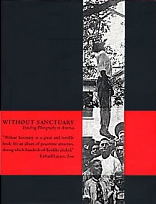Book Notes
 Without Sanctuary; Lynching Photography in America, with introductory essays by James Allen, Hilton Als, Congressman John Lewis, and Leon F. Litwack (Santa Fe: Twin Palms Publishers, 2000), 209pp.
Without Sanctuary; Lynching Photography in America, with introductory essays by James Allen, Hilton Als, Congressman John Lewis, and Leon F. Litwack (Santa Fe: Twin Palms Publishers, 2000), 209pp.
They say a picture's worth a thousand words, but no words can describe, let alone explain, the horrific crimes against humanity documented in this photographic history of lynching in America—and not "just" hangings, but burnings, castration, mutilation, and sadistic tortures like cutting unborn babies from their mother's womb. Nor do the four introductory essays (pp. 7–44) and the notes to the 98 photographic plates make for easy reading. This is a significant if revolting part of American history, even if high school history courses never mention it.
"In the late nineteenth and early twentieth century," writes Leon Litwack, "two or three black southerners were hanged, burned at the stake, or quietly murdered every week. In the 1890s, lynchings claimed an average of 139 lives each year, 75 per cent of them black. The numbers declined in the following decades, but the percentage of black victims rose to 90 percent. Between 1882 and 1968, an estimated 4,742 blacks met their deaths at the hands of lynch mobs." These are only the documented cases, and they don't include the "legal lynchings" of perverted "justice," or private posses on "nigger hunts."
Some lynchings were done in isolated and remote areas by psychopaths. But as this volume shows, they were not only public events but public spectacles that were advertised, described by lurid media headlines ("colored man roasted alive"), and attended by thousands of voyeuristic spectators. They were carried out by and celebrated by leading citizens, state and federal congressmen, and leaders in business and church. "Our American Christians," wrote the anti-lynching activist Ida B. Wells, "are too busy saving the souls of white Christians from burning in hell-fire to save the lives of black ones from present burning in fires kindled by white Christians." There was no due process of law in most of these lynchings, nor any attempt to hide the identity of the executioners. The US postal service was happy to mail commemorative post cards with pictures of lynchings. Trains provided free services to the spectacles. Yes, there were lone dissenting voices, but far too few. For a narrative history of lynching see Philip Dray, At the Hands of Persons Unknown; The Lynching of Black America.


